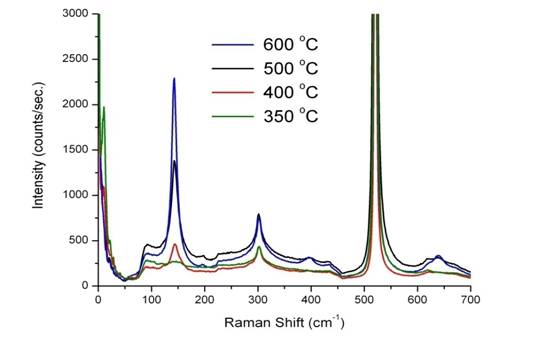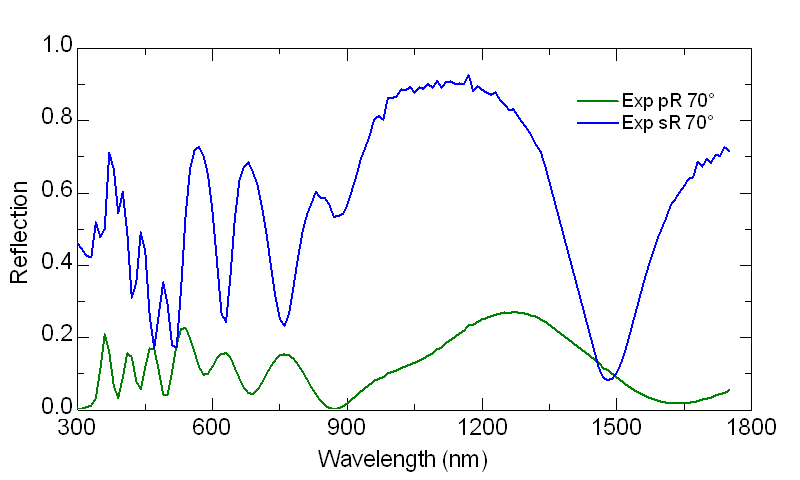Reports: B10
48489-B10 Photonic Crystals-based Hybrid Structures for Laser and Photovoltaic Applications
During the past year, we have focused primarily on three projects related to the proposed work on photonic crystals-based hybrid structures for laser and photovoltaic applications. In the first project, we investigated a series of TiO2 nano-structures using Raman spectroscopy, in order to understand how the crystal size and shape alter the structural and optical properties. In the second project, we investigated the growth and characterization of 1-D photonic crystals which were composed of SiO2 and TiO2 films. In the final project, we studied the growth dynamics as well as the optical properties of a hybrid structure composed of a defect-layer (mesoporous silica) sandwiched between two 3-D photonic crystals.
A. Raman Studies of Nanocrystalline TiO2
Mesoporous titania, once fabricated using template-based evaporation techniques, can be further transformed to exhibit different crystal structures as well as to change its crystal size by subsequently annealing the films. The goal of the current proposal has been to investigate potential films that are capable of manifesting varying optical properties, and to exploit these characteristics in order to fabricate hybrid structures. Using mesoporous-TiO2, we were interested in exploring the changes to both optical and vibrational spectra as a result of the crystal structure and crystal size. We used a mesoporous-TiO2 film that was annealed at different temperatures to perform these studies. As shown in Fig. 1, the Raman spectra obtained for these samples show a drastic change for the mode near 150 cm-1, a mode that signifies the presence of anatase in the film. The increase in the intensity with the annealing temperature predicts the increase of anatase in the film.
Figure 1: Raman spectra for a series of mesoporous titania films annealed at different temperatures.
Additionally, we found that the antase-peak near 150 cm-1 red-shifts with increasing temperature, a result that indicates the effect of crystal size on the vibrational modes. We analyzed this effect for two types TiO2 films; cubic and hexagonal. As shown in Fig. 2, we observed the red-shift for both types of structures. We are currently investigating a theoretical model that will explain the experimental result, and are hoping to publish this exciting result in the near future.
Figure 2: Red shift of the anatse line near 150 cm-1 shown for both cubic and hexagonal mesoporous titania films as a function of the annealed temperature.
B. 1-D Photonic Crystals Composed of TiO2 and SiO2
It is known that, in photovoltaic devices, the light capture efficiency can be enhanced by coupling 1-D photonic crystals (PCs). We grew a series of 1-D PCs using mesoporous SiO2 and TiO2 in order to investigate their ability to be coupled with photovoltaic structures. After having grown several independent films of SiO2 and TiO2 and examining their thicknesses and the indices of refraction using ellipsometry, we developed a calibration curve for these two materials. It has to be noted that these two materials are very interesting because by changing the growth conditions (i.e., surfactant to precursor ratio), one can vary the porosity, which then changes the index of refraction of the film. By combining films of SiO2 and TiO2 with different porosities, and by carefully manipulating their thicknesses, one can obtain 1-D PCs that manifest a pronounced reflectivity at a specific wavelength.
After obtaining the necessary calibration curves, we fabricated multilayer structures of SiO2 and TiO2 thin films with careful combinations of thicknesses and indices of refraction in order to obtain the highest possible reflectivity. In Fig. 3, we show the reflectivity for a sample which has six layers of SiO2 and TiO2 (i.e., three periods) obtained at an angle of incidence of 75 degrees. The reflectivity of 90% obtained for this structure was very encouraging. We encountered several issues when the number of periods was increased in order to further increase the reflectivity. It seems that after a certain thickness, the whole structure begins to crack and prevent the deposition of any more over-layers. We are investigating these issues thoroughly, and trying to optimize the growth of these 1-D PCs in order to enhance their reflectivity.
Figure 3: Reflectivity spectrum of a 3-period SiO2 and TiO2 structure obtained at 75 degrees for both p and s-polarizations.
C. 3-D Photonic Crystals with Defect Layers
Analogous to the doping process of semiconductors, the introduction of defects in to a PC allows one to access the states in the forbidden range, resulting in the propagation of forbidden frequencies through the material. One of the clever methods in which a planar-defect-mode can be incorporated into PC is by introducing a thin-layer inside the PC. If the thin-layer also has an active emitter embedded in it (such as quantum dots or dyes), and the planar-defect-mode is resonant with the emitter, significant enhancements of the emission could be achieved due to the cavity-emitter dynamics.
During the past year, we have focused on fabricating and characterizing a SiO2 mesoporous film sandwich between two identical self-assembled PCs. In this particular case the mesoporous film acts as both a cavity as well as a defect-layer, allowing a range of wavelengths to transmit which were previously forbidden. This transmission is represented by a dip in the reflectivity. The structures that we have fabricated so far show these dips, but not so distinctly. We are in the process of optimizing our growth mechanisms in order to obtain fairly stable structures. In the next year, we want to investigate on how to attach quantum dots into the mesoporous layers so that we are able to enhance its emission.







